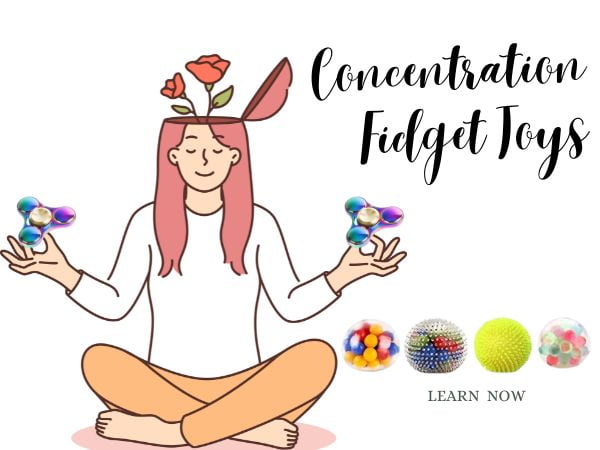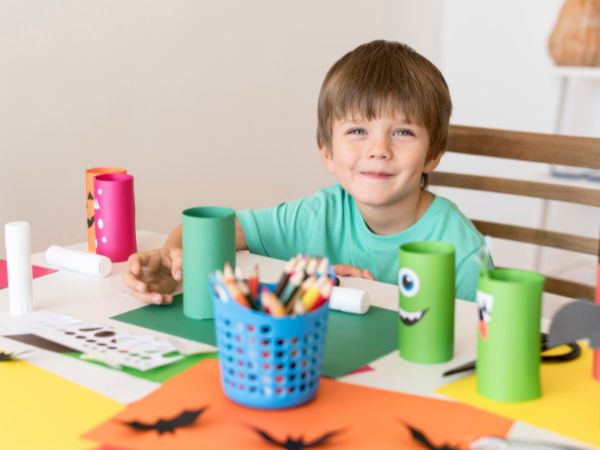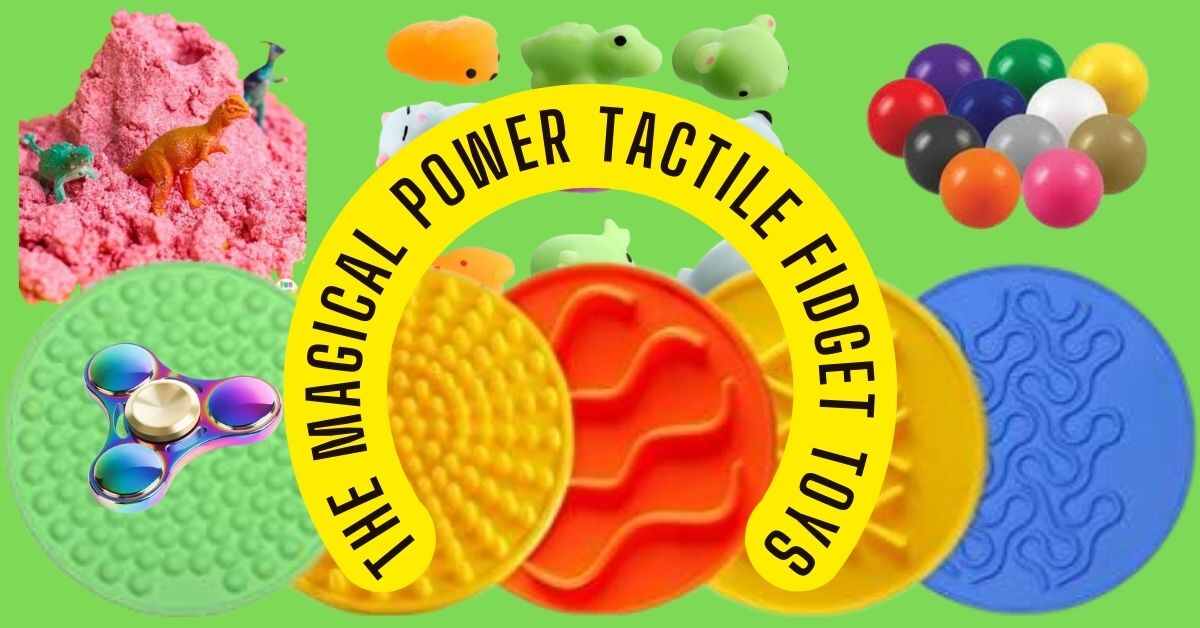I. Introduction
Welcome to the era of perpetual distractions, where our attention is constantly tugged by the digital world. But fear not, as we explore the world of concentration fidget toys, your ticket to undistracted bliss. In this section, we set the stage, acknowledging the prevalent issue of distraction in today’s fast-paced world and introducing concentration fidget toys as a potential solution.
Table of Contents
II. Benefits of Concentration Fidget Toys
Concentration fidget toys offer a range of benefits that make them valuable tools for individuals seeking to enhance focus and manage stress. Here are some of the key advantages:
- Stress Reduction: Fidget toys provide a physical outlet for stress and nervous energy, helping to alleviate tension and promote a sense of calm. The repetitive motion or tactile sensation of concentration fidget toys can have a soothing effect on the nervous system.
- Increased Focus and Productivity: Engaging with fidget toys can enhance concentration and productivity by redirecting excess energy. For individuals who struggle with maintaining attention or have a tendency to fidget, these toys offer a non-disruptive way to channel that energy, allowing for improved focus on tasks.
- Suitable for Various Age Groups: Concentration fidget toys come in a variety of forms, which make them versatile and suitable for individuals of different ages. Whether used in educational settings for children, or in professional environments for adults, these toys can be adapted to meet the needs of various age groups.
III. Types of Concentration Fidget Toys
There are various types of concentration fidget toys, each catering to different preferences and sensory needs. Here are some popular types:
1. Stress Balls:

- Description: Stress balls are pliable, squeezable objects usually made of rubber or foam. They are of different sizes and shapes.
- Uses: Designed to relieve stress and muscle tension by providing a simple outlet for squeezing and releasing.
- User Review: “It is great for quick stress relief, fits easily in my hand, and helps me to stay focused during work.” – 4.5/5 stars.
2. Fidget Spinners:

- Description: It is a small, palm-sized gadget with a central ball bearing that allows them to spin. It is often made of plastic or metal.
- Uses: Originally marketed to help with concentration and reduce anxiety by providing a simple spinning motion.
- User Review: ” A traditional tool for reducing stress and keeping focus is the fidget spinner. Its smooth spin and satisfying rotation make it a great go-to fidget toy.” – 3.5/5 stars.
3. Tactile Stones:

- Description: It is a Smooth, handheld stone used for tactile stimulation. They have a variety of forms and textures.
- Uses: Intended to provide a calming sensory experience through touch and manipulation.
- User Review: “Love the different textures! Great for keeping my hands busy during meetings without being distracting.” – 4/5 stars.
4. Squishy Toys:
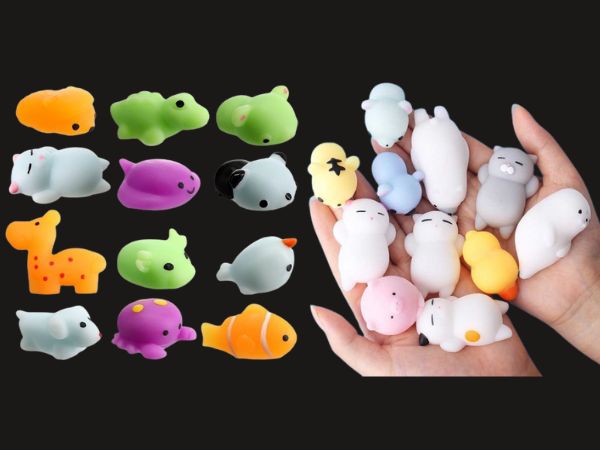
- Description: Soft and squeezable toys are often shaped like animals or objects. Made from slow-rising foam.
- Uses: Offers a stress-relieving experience through squishing and manipulating the soft material.
- User Review: ” Squishing it is so enjoyable and adorable. Great for winding down after a hectic day.” – 4.2/5 stars.
5. Sensory Rings:
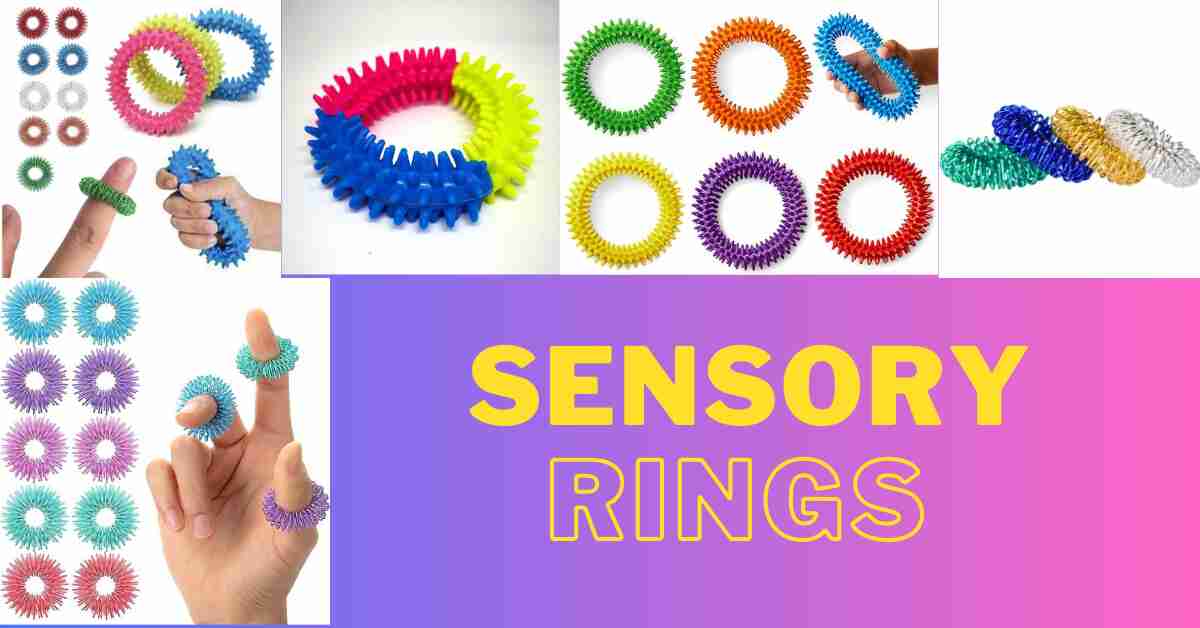
- Description: Small, textured rings designed to be worn on fingers, providing sensory feedback.
- Uses: Geared towards individuals who benefit from tactile stimulation, aiding in focus and stress reduction.
- User Review: “Simple yet effective. I wear them discreetly during meetings to help stay grounded.” – 4.3/5 stars.
6. Tangle Toys:

- Description: Interconnected, twistable segments forming a loop. Comes in various colors and textures.
- Uses: Intended to promote tactile stimulation and aid in maintaining focus through twisting and fidgeting.
- User Review: “Highly addictive! Keeps my hands busy during calls, and the different textures are a nice touch.” – 4.7/5 stars.
7. Desk Toys:
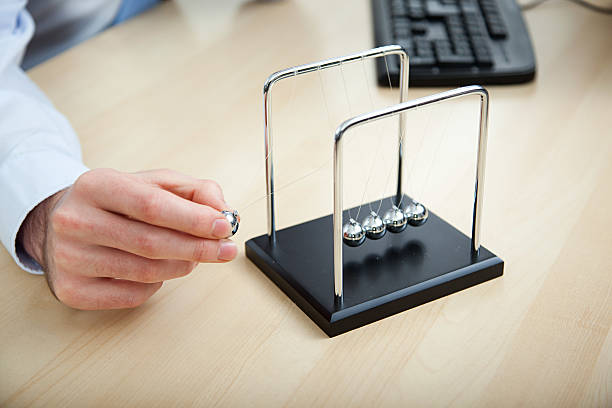
- Description: Various small toys such as Newton’s cradle, kinetic sculptures, or magnetic desk toys.
- Uses: Designed for distraction-free fidgeting at a desk, offering both visual and tactile stimulation.
- User Review: “Perfect for my workspace. Provides a mental break without being too disruptive. Love the magnetic sculptures!” – 4.6/5 stars.
IV. How Concentration Fidget Toys Work
- Tactile Stimulation: Fidget toys stimulate the sense of touch through tactile stimulation, which helps to focus attention and deflect the mind from other distractions. The toy’s tactile engagement produces a sensory experience that draws the attention of the brain.
- Mindful Engagement: Purposeful fidgeting encourages attentive presence in the moment. The intentional and repetitive movements required to use a fidget toy help to tie the user to their current task, encouraging awareness and attention, as opposed to allowing the mind to wander.
- Stress Relief Mechanisms: By giving nervous energy a release, fidget toys act as stress relievers. Fidgeting is a healthy way to relieve stress, lower anxiety, and promote calmness, all of which can enhance mental health in general.
V. Choosing the Right Concentration Fidget Toy
Hey there! So, you’re on the lookout for the perfect concentration fidget toy? Awesome! Let’s dive into this exciting journey of finding the one that suits you like a glove.

First off, think about your personal preferences – what gets your focus gears grinding? Are you into soft textures that soothe your senses, or maybe you’re more of a click-and-press kind of person? It’s like choosing your favorite ice cream flavor – go with what makes you light up!
Now, let’s talk about distraction levels. Some of us need just a sprinkle of distraction to get those creative juices flowing, while others might crave a bit more to really hit that sweet spot of concentration. So, ask yourself, are you a team subtle twirl or a team intricate twist?
It’s like finding a musical rhythm that syncs with your soul – you want that fidget toy to harmonize with your concentration needs. Trust me, when you discover the one that resonates with you, it’s like finding a secret weapon for battling distraction monsters.
So, go ahead, explore the concentration fidget toys universe, and let your instincts guide you. Whether it’s a stress ball, a spinner, or something entirely out of the box, embrace the journey of choosing the right concentration companion. Happy fidgeting! 🌟
VI. Concentration Fidget Toys in the Workplace: A Practical Guide
Welcome to the ultimate guide for bringing concentration fidget toys into your workplace – because who said work can’t be a playground for focus and creativity? Let’s turn those office vibes into a space where your mind dances with ideas!
First off, let’s talk about enhancing focus during tasks. Imagine having a little sidekick on your desk – a fidget toy that keeps your hands engaged while your brain does its thing. It’s like having a personal cheerleader for your concentration, boosting you through every task with a dash of fun.
Stress at work? We’ve all been there. Enter the fidget toy – a tiny stress-buster that fits right into your hands. Squeeze away the tension, twirl away the worries – it’s like having a mini-vacation for your mind without leaving your desk. Your stress levels won’t know what hit them!
Now, let’s sprinkle some magic on creativity and problem-solving skills. Picture this: you’re brainstorming, and your fingers are dancing with a fidget spinner. Suddenly, ideas flow like a river, and problem-solving becomes a breeze. It’s not just a toy; it’s your creativity ally, ready to ignite those lightbulb moments.
And guess what? Bringing fidget toys to the workplace isn’t just about you – it’s about promoting a healthy work environment. Picture a team where everyone has their personalized concentration tool, creating a symphony of focused minds. It’s not just about work; it’s about fostering a space where well-being and productivity go hand in hand.
So, whether you’re a desk ninja or a boardroom maestro, consider introducing concentration fidget toys to your workplace. It’s not just a trend; it’s a movement towards a more focused, creative, and stress-free work environment. Let the fidget revolution begin! 🚀
VII. Concentration Fidget Toys for Students
Alright, fellow students, gather ’round because we’re about to embark on the journey of concentration fidget toys – the secret weapon for acing your studies and turning classrooms into focus havens!
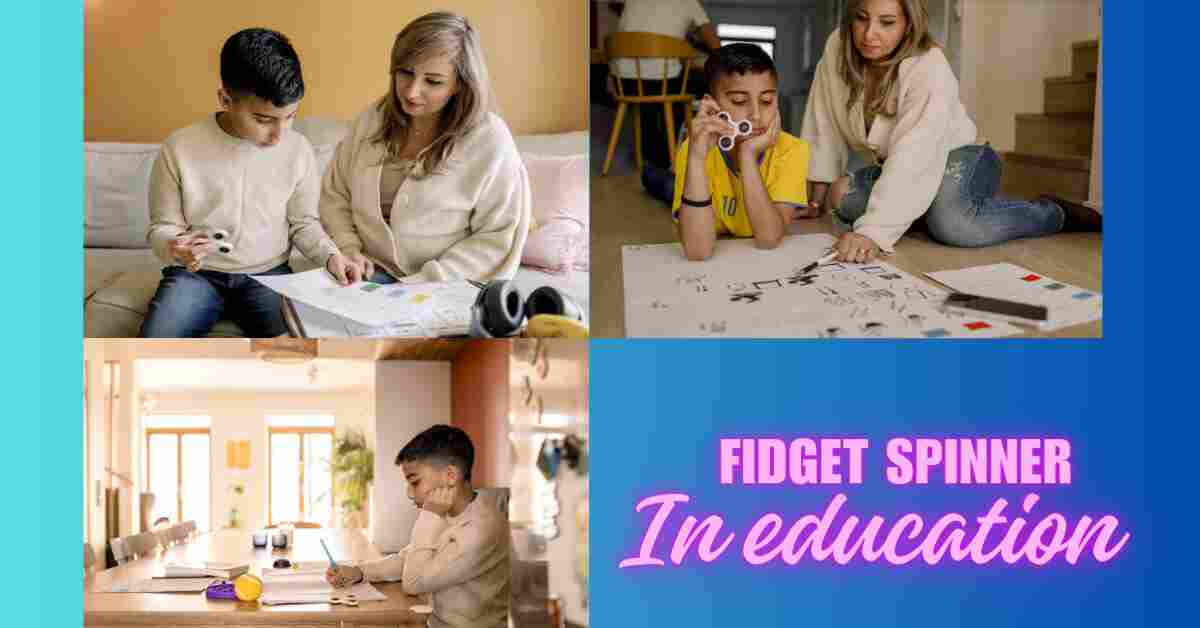
First things first, let’s talk about bringing these magical tools into classrooms. Imagine a world where your desk is not just a sea of textbooks but also a playground for focus. Fidget toys seamlessly integrated into classrooms – it’s like turning your study space into a personal concentration oasis.
Now, let’s dive into the attention game. Concentration fidget toys aren’t just cool gadgets; they’re attention boosters. Picture yourself in class, fiddling with a stress ball or spinning a little spinner. Suddenly, the lecture becomes a captivating adventure, and your focus levels hit the roof. It’s like having a superpower for attention – and who doesn’t want that?
But wait, there’s more! These nifty tools don’t just improve attention; they have a downright positive impact on learning. It’s like adding a pinch of excitement to every lesson, turning studying into a dynamic experience. Learning becomes less of a chore and more of a thrilling journey.
Now, let’s talk about the challenges of remote learning. Fidget toys are like your virtual study buddies, making those Zoom classes a tad more engaging. Whether you’re dealing with a stress ball during a virtual lecture or spinning away while tackling assignments, these toys become your allies in the battle against digital distractions.
And here’s the heart of the matter – addressing ADHD and anxiety in students. Fidget toys aren’t just for fun; they’re a lifeline for those dealing with attention challenges or anxiety. It’s like having a tool that understands you and supports you through the ups and downs of the academic journey.
So, fellow learners, consider introducing concentration fidget toys into your study routine. It’s not just about gadgets; it’s about turning your learning experience into a captivating adventure. Let the focus games begin! 📚✨
VIII. Fidget Toys Beyond Concentration
- Relaxation and Mindfulness: Beyond their role in concentration, fidget toys also contribute to relaxation and mindfulness. The calming effects of tactile engagement extend to overall mental well-being, promoting a sense of tranquility and stress relief.
- Therapeutic Applications: In therapeutic settings, fidget toys are increasingly recognized as valuable tools. They are used to support individuals with various conditions, including anxiety disorders, autism spectrum disorders, and attention-deficit/hyperactivity disorder (ADHD).
- Holistic Well-Being: Embracing fidget toys as part of a holistic well-being approach acknowledges their multifaceted benefits. By addressing not only focus and concentration but also stress management and relaxation, these tools contribute to a more balanced and fulfilling life.
IX. DIY Concentration Fidget Toys
Alright, my creative pals, gather ’round because we’re about to dive into the world of DIY concentration fidget toys – the ultimate blend of fun and focus, all wrapped up in a burst of creativity!

First things first, let’s talk about engaging in a creative process. Picture this: you’re surrounded by colorful materials, your hands busy crafting your very own fidget masterpiece. It’s not just a toy; it’s an artistic journey, a chance to let your imagination run wild. The process of creating becomes a zen zone, a delightful escape from the hustle and bustle.
Now, let’s talk about the joy of cost-effective alternatives. Who says you need to break the bank for a fantastic fidget toy? With a bit of imagination and some everyday items, you can whip up your very own concentration companion without spending a fortune. It’s like turning mundane objects into sources of endless focus and amusement.
Imagine crafting a stress ball filled with the softness of your favorite fabric or creating a spinner from materials lying around the house. Each DIY fidget toy becomes a unique expression of your personality, tailor-made to suit your preferences. It’s not just about the end result; it’s about the joy of the creative journey.
So, grab your crafting supplies and let your inner DIY guru shine. Transform ordinary items into your personalized focus tools, infusing each creation with a bit of your own magic. It’s not just about the fidget toy; it’s about the satisfaction of saying, “Hey, I made this, and it’s awesome!”
Get ready to embark on a creative adventure, my friends. DIY concentration fidget toys are not just projects; they’re gateways to a world where focus meets imagination. Let the crafting begin! 🎨✨
X. Controversies Surrounding Concentration Fidget Toys
Oh, the fidget toy frenzy – a storm of controversy that has parents, teachers, and therapists caught in a whirlwind of conflicting emotions.

First, the distraction drama unfolds. In classrooms, fidget spinners and stress balls transform into attention-stealing acrobats, turning what was meant for focus into a circus of chaos. Teachers grapple with the challenge of reigning in wandering minds, as students twirl their toys into gravity-defying distractions.
Then comes the plea for guidelines – the cry for a rulebook on proper usage. Should these gadgets be discreetly manipulated or proudly displayed? A moral dilemma surfaces: are fidget toys tools for self-regulation or Pandora’s boxes of disruption?
Parents, torn between supporting focus and fearing classroom chaos, struggle to enforce rules as elusive as a slippery eel. The debate rages on, echoing the clatter of fidget toys against tabletops.
In this emotional whirlpool, the question lingers – are fidget toys friends or foes? As the controversy continues its rollercoaster ride, one thing is certain: opinions flare, and emotions run as high as the stakes. Buckle up for the twists and turns of this heated discussion, where everyone has an opinion, and the only certainty is the storm shows no sign of calm.
XI. Scientific Perspective on Fidgeting
The scientific perspective on fidgeting has evolved over the years, and researchers have explored the impact of fidgeting on concentration as well as the potential cognitive benefits of controlled fidgeting. Here’s an overview:
1. Impact of Fidgeting on Concentration:
- Early Beliefs: Traditionally, fidgeting was often seen as a sign of distraction and lack of focus. The belief was that individuals who fidgeted were not fully engaged in the task at hand, leading to assumptions that it could impair concentration.
- Recent Research: Contrary to earlier assumptions, some recent research suggests that fidgeting might not necessarily be detrimental to concentration for everyone. It’s important to recognize that people have different learning styles and attention spans, and for some individuals, a certain level of movement or fidgeting might actually enhance their ability to concentrate.
- Individual Differences: The impact of fidgeting on concentration may vary from person to person. Some individuals might find fidgeting distracting, while others may experience improved focus and attention when engaging in controlled, purposeful movements.
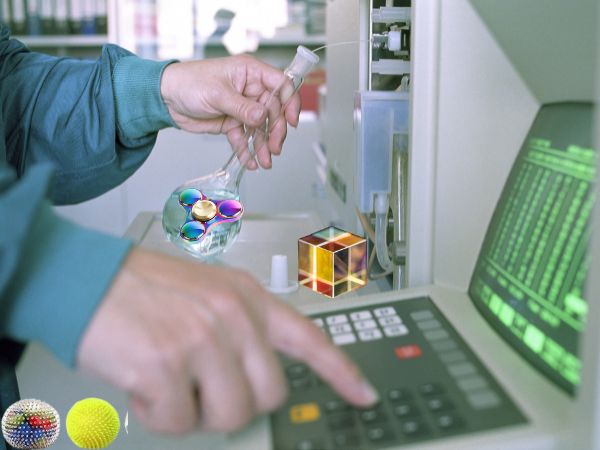
2. Cognitive Benefits of Controlled Fidgeting:
- Stress Reduction: Controlled fidgeting, such as using stress balls or other fidget tools, has been associated with stress reduction. The physical act of fidgeting can serve as a stress outlet and may help individuals manage anxiety or nervous energy, contributing to an overall sense of well-being.
- Enhanced Focus for Some: For certain individuals, engaging in controlled fidgeting activities might stimulate parts of the brain and enhance cognitive function. This can be particularly true for tasks that require a balance between focused attention and creativity.
- Kinesthetic Learning: Some people are kinesthetic learners, meaning they learn best through physical movement. For these individuals, incorporating controlled fidgeting into the learning process may improve information retention and understanding.
3. Considerations and Recommendations:
- Context Matters: The appropriateness of fidgeting may depend on the context, environment, and nature of the task at hand. In a classroom or workplace setting, it’s crucial to balance individual needs with the potential impact on others.
- Individualized Approaches: Recognizing that people have different preferences and responses to fidgeting, a more individualized approach to learning and work environments may be beneficial. Providing options for individuals to choose fidgeting tools or techniques that work for them can be a positive step.
- Further Research: The field of study on fidgeting is ongoing, and more research is needed to understand the nuances of its impact on concentration and cognitive function. Continued investigation will contribute to refining our understanding of the relationship between movement and cognitive performance.
XII. Social Acceptance and Stigma
Changing Perceptions of Fidgeting in Public Spaces:
- Evolution of Understanding: Over time, societal perceptions of fidgeting in public spaces have undergone a shift. Historically associated with distraction or lack of discipline, there’s a growing awareness that fidgeting can be a coping mechanism or a tool for concentration.
- Awareness Campaigns: Advocacy groups and educational campaigns have played a role in disseminating information about the diverse reasons behind fidgeting. By promoting understanding, these initiatives aim to reduce the stigma associated with fidgeting in various settings, including schools, workplaces, and public places.
- Education on Neurodiversity: Increased awareness of neurodiversity has contributed to changing attitudes. Understanding that individuals with different neurodivergent conditions may use fidgeting as a way to manage sensory input has fostered a more empathetic approach.
- Inclusive Design: Public spaces are increasingly designed with inclusivity in mind. This includes considerations for individuals who may benefit from fidget-friendly elements, such as quiet corners, sensory-friendly features, or discreet fidget tools.

Encouraging a More Inclusive Mindset:
- Promoting Acceptance: Encouraging a more inclusive mindset involves actively promoting the acceptance of diverse behaviors, including fidgeting. This can be achieved through educational programs, workplace training, and community initiatives that emphasize the importance of understanding and embracing differences.
- Accommodation in Educational Settings: Educational institutions are working towards creating environments that accommodate various learning styles. Recognizing that fidgeting can be a self-regulation strategy, schools are adopting policies that allow for discreet fidget tools in classrooms to support students’ needs.
- Workplace Flexibility: Progressive workplaces are adopting flexible policies that acknowledge and accommodate diverse working styles. This may involve providing options for ergonomic furniture, allowing flexible workspaces, or permitting the use of discreet fidget tools to enhance employee well-being and productivity.
- Open Dialogue: Fostering an open dialogue about fidgeting helps break down stereotypes and misconceptions. Encouraging conversations about the diverse reasons behind fidgeting behaviors can contribute to a more supportive and understanding community.
- Modeling Inclusivity at Leadership Levels: Leadership plays a crucial role in setting the tone for an inclusive environment. When leaders embrace diversity and demonstrate an understanding of different needs, it sets an example for others to follow, creating a culture of acceptance.
- Legislation and Policies: Some regions are considering or implementing legislation and workplace policies that explicitly address the rights of individuals with diverse needs, including those who may benefit from fidgeting. These measures aim to protect individuals from discrimination based on their neurodivergent characteristics.
XIII. FAQs About Concentration Fidget Toys
1. Can fidget toys really improve focus?
Ans: Yes, fidget toys have been shown to improve focus by providing a constructive outlet for excess energy and promoting mindful engagement.
2. Are fidget toys only for children with ADHD?
Ans: No, fidget toys are beneficial for individuals of all ages and can be effective tools for managing stress, increasing focus, and promoting relaxation.
3. Do fidget toys have any scientific backing?
Ans: Absolutely, scientific studies have explored the cognitive and emotional benefits of fidget toys, demonstrating their positive impact on brain function and mood regulation.
4. Can I use fidget toys in a professional setting without judgment?
Ans: Increasingly, workplaces are recognizing the benefits of fidget toys, and their use is becoming more accepted as a means of enhancing focus and reducing stress.
5. Are there specific fidget toys recommended for certain conditions?
Ans: Yes, certain fidget toys may be more suitable for specific conditions. It’s essential to consider individual preferences and sensory needs when choosing a fidget toy.
XIV. Conclusion:
In summary, concentration fidget toys offer diverse benefits, enhancing focus, managing stress, and supporting neurodivergent individuals. Encouraging experimentation with these tools allows for individualized solutions. By cultivating a positive mindset towards fidgeting, we promote inclusivity and acknowledge the unique ways individuals navigate their cognitive processes. Embracing the benefits of concentration fidget toys contributes to a more understanding and supportive society.
Disclaimer:
The information provided in this article on Concentration Fidget Toys is for general informational purposes only. The article is not intended to be a substitute for professional advice, diagnosis, or treatment. Always seek the advice of your physician or other qualified health provider with any questions you may have regarding a medical condition.
